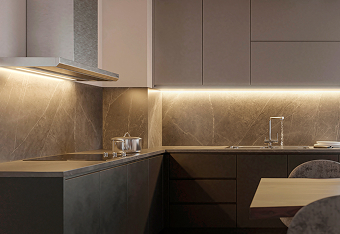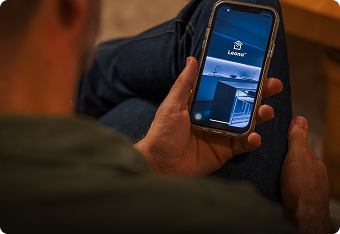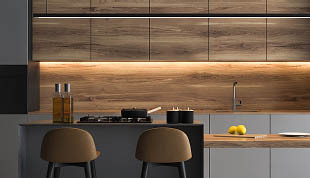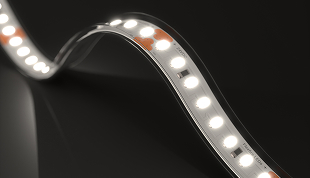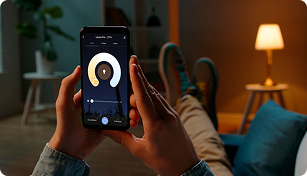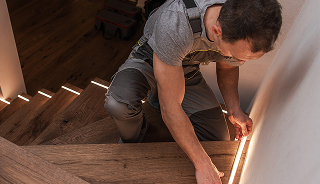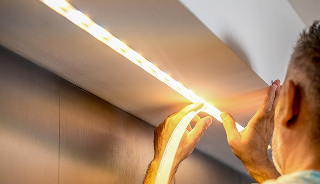August 10, 2021 by Brenton Mauriello
What is Dynamic Tunable White Lighting and What are the Benefits?
Tunable white lighting technology is defined as the ability to control a light source’s color temperature output. It is also referred to as variable white, dim-to-white, hybrid white, or custom temperature lighting from other manufacturers. This is done by manufacturing the strip light or PCB with different color temperature LEDs. Using a remote control or external control system such as DMX, you are able to select the desired color of white anywhere between the available range specified by the manufacturer.
First of all, How do we classify "white" light? What is CCT?
When you go to the hardware store and choose a light bulb, sometimes they are classified as either warm or cool, daylight, bright white, or soft white. These names are used to specify the color temperature of white that is emitted from the light source. The color of white light can be quantified by referring to its color temperature. To better understand the difference in variable white lights / tunable white lighting, you need to understand what correlated color temperature is:
CCT (Correlated Color Temperature) refers to the color temperature of light, measured in degrees Kelvin (K). The temperature rating directly correlated to what the white light will look like to us humans. Within the LED industry, it is typical to see white LEDs created anywhere between 1800K (candlelight) and 7000K (daylight).
For instance, a light source that has a 3000K rating known as what we collectively call, "warm white" lighting. Warm white light looks very orange and/or yellow. Traditional Halogen and Incandescent lighting is also around 3000K. When increasing the degrees Kelvin, the color will change from yellow to yellowish white to white and then a bluish white (which is the coolest white).
Although the varying temperatures have different names, it should not be confused with actual colors such as red, green, or purple. CCT is specific to white light.
On the market, you may find products related to this using different names. Dynamic tunable white lighting is also called:
- Variable white
- Hybrid white
- CCT changing led strip lights
- Dim to warm
- Circadian rhythm lighting
What are the Benefits of Tunable White LED Lighting?
Whether you’re thinking about getting tunable lighting for your home, office, or a commercial facility, there may be times you want to have the option to change the light for various reasons. For instance, a restaurant may want to have varying CCT capabilities for different events or parts of their service to create different moods while a hospital may want to have cooler light during the day to help patients be more alert and warmer light at night to help them relax. Having the option to control the lighting can be beneficial in several ways:
- Health Benefits - Your Circadian Rhythm and lighting
- Increased productivity
- Sustainability
- Design Focus
Circadian Rhythm Manipulation Through Lighting
In essence, your Circadian Rhythm is your body’s clock. Your body naturally knows when to wake up and when to sleep. At all times of the day, your body is supposed to have a natural rhythm that guides your alertness, sleeping, and eating patterns. Studies of the Circadian Rhythm have shown that the intensity, timing, duration, and wavelength of light can affect the biological clock of humans.
In other words, our circadian rhythm can be interrupted by our constant use of bright man-made lighting (think about using your bright phone screen at night in bed). Disruptions in this rhythm can result in health issues such as obesity, cardiovascular and neurological problems like sleep disorders. Researchers have found that CCTs above 5500K (containing a high amount of blue light) can disrupt our circadian rhythm by keeping us up when we should naturally be sleeping.
Brighter "cool" lights keep us alert and awake. This, in turn, prevents us from resting our bodies and recharging for the next day’s activities. Tunable white LED lighting enables us to return to our natural circadian rhythm by giving us that range of lighting in either our homes or in the workplace. In the daytime when you need to focus, you can change the lighting to 6000K while in the evening before bed, you can decrease the CCT to 3000K, promoting the natural release of melatonin to help you sleep.
Modified Graphic; Original Source: Rhythms of life: circadian disruption and brain disorders across the lifespan
Apart from preventing health issues, tunable white LED lighting can also help regain healthy habits and normality in hospital patients. Many hospitals worldwide are now utilizing tunable white LED lighting not only as an energy saver, but they find that bright blue lighting increases a healthy appetite, increase in temperature and heart rate, and increased cognitive function. At night, warmer lighting allows for the calm low hormone levels and healing of patients. Not only that, but having a warmer lighting allows for medical staff to complete rounds without disrupting a patient's sleep.
When using lighting to assist in maintaining your circadian rhythm, you’ll likely be more productive and have better sleep. Your body uses sunlight to tell when certain things should happen, such as waking up or sleeping. So, if you’re indoors most of the day, circadian rhythm lighting can help your body function at its best and then start winding down at the right time to help you have the best sleep at night.
Increased Productivity
Many of us have heard theories about the way that colder rooms in workplaces or educational settings help concentration. Working under the right lighting also helps us work diligently and increases our productivity ratios. Having the ability to tune the lights according to the needs of moods have a definite impact on productivity because of our circadian rhythm. If we are in a well-lit environment that natural mode is stimulated and we are much more energetic and focused. The following list further supports this lighting theory and allows us to see all the different places where lighting can be a positive influencer.
Classrooms
Researchers have found that higher CCT lighting between the 4000K and 6000K helps with alertness and have dubbed this lighting “focus lighting”. The “focus lighting” used in a case study with third graders increased their oral reading fluency performance by almost 40 percent compared to normal controlled lighting.
In the same way that brighter lighting creates alertness, warmer lighting ensures tranquility, which is also a way to increase productivity in a classroom. Longer hours create restlessness in children. Tuning lights to 3000K helps with an easier transition from lunchtime and recess activities to independent work.
Offices
Employees in a professional environment can also benefit from tunable white lighting. In an office setting, brighter lights seem to work better during the early hours and increase work-flow, whereas softer lights seem to work better with concentration in the evenings when everyone is jittery waiting for the clocks to strike that last working minute. This natural transition between brighter lights in the early hours and warmer lights in the evenings reflect our natural states and thus manipulate our moods. You can also use the lighting to create a specific mood/emotion for your customers who walk into your store.
How can you use Tunable Dynamic White Lighting?
Whether you choose to use tunable white lighting options to control ambiance or for health benefits, there are many different ways you can add tunable white LED strips to your décor. It can be used in just about any place. Below are some places that take advantage of dim to warm lighting:
- Residences
- Architecture
- Hospitality
- Hospitals
- Healthcare facilities
- Classrooms
- Offices
- Retail Stores
Importance in Design and Architecture
We believe that lighting is not something that should be considered as a final touch or an accessory to design. Lighting is just as important as the wood selection, angles of the structure, or color of the paint. Something important to note about tunable white lighting is that regardless of the style of architectural or interior design, accommodating lighting in order to enhance certain aspects of the building is crucial for the achievement of a certain look and quality. With this technology, you are able to not only dial in the perfect color of light to compliment or complete your vision, but you have full control to change the color depending on a future desired look.
How do Flexfire LEDs use Tunable White Technology?
We have implemented this technology into our specification grade LED strip lighting products. Using alternating LED chips of different color temperatures, you are able to use one strip and a remote to blend the LEDs and control the strip light’s output anywhere within the specified range. We offer a variety of CCT ranges that can best suit your project’s application:
What Ranges do We Offer?
Sienna™ Dim-to-Warm Series (medium brightness)
- Available in 3000K-1800K ranges
Accent™ Dynamic Tunable White Series (medium brightness)
- Available in 2400K-6200K ranges
Architectural™ Dynamic Tunable White Series (High brightness)
- Available in 2400K-6200K
Dynamic Tunable White lighting is one of the most innovative changes in lighting technology in recent years. The ability to have full control over the CCT of your light source was previously inconceivable. Dynamic white lighting is not only important from a function and design approach, but for human centric and health-conscious reasons. It also looks quite beautiful.
Related Posts
Circadian Rhythm Lighting
Circadian lighting can help realign your circadian rhythm, guaranteeing deeper sleep and promoting overall long-term health.
How to Install LED Cove Lighting
If you want to know how to choose the best LED strip light for cove lighting and learn how to install LED strip lights at home, read this guide.


